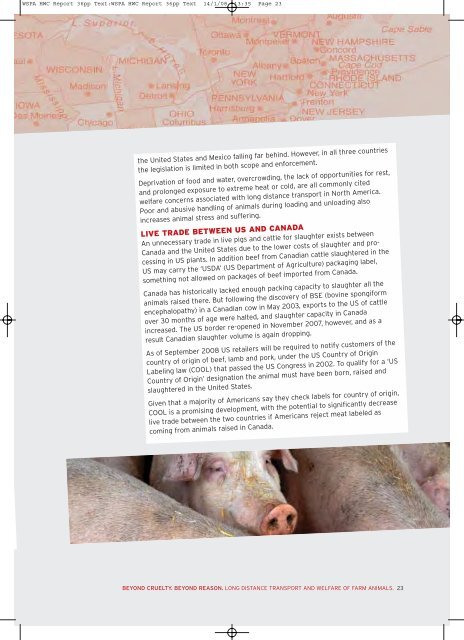Long Distance Transport and Welfare of Farm Animals
Long Distance Transport and Welfare of Farm Animals
Long Distance Transport and Welfare of Farm Animals
- No tags were found...
You also want an ePaper? Increase the reach of your titles
YUMPU automatically turns print PDFs into web optimized ePapers that Google loves.
WSPA HWC Report 36pp Text:WSPA HWC Report 36pp Text 14/1/08 13:35 Page 23the United States <strong>and</strong> Mexico falling far behind. However, in all three countriesthe legislation is limited in both scope <strong>and</strong> enforcement.Deprivation <strong>of</strong> food <strong>and</strong> water, overcrowding, the lack <strong>of</strong> opportunities for rest,<strong>and</strong> prolonged exposure to extreme heat or cold, are all commonly citedwelfare concerns associated with long distance transport in North America.Poor <strong>and</strong> abusive h<strong>and</strong>ling <strong>of</strong> animals during loading <strong>and</strong> unloading alsoincreases animal stress <strong>and</strong> suffering.LIVE TRADE BETWEEN US AND CANADAAn unnecessary trade in live pigs <strong>and</strong> cattle for slaughter exists betweenCanada <strong>and</strong> the United States due to the lower costs <strong>of</strong> slaughter <strong>and</strong> processingin US plants. In addition beef from Canadian cattle slaughtered in theUS may carry the ‘USDA’ (US Department <strong>of</strong> Agriculture) packaging label,something not allowed on packages <strong>of</strong> beef imported from Canada.Canada has historically lacked enough packing capacity to slaughter all theanimals raised there. But following the discovery <strong>of</strong> BSE (bovine spongiformencephalopathy) in a Canadian cow in May 2003, exports to the US <strong>of</strong> cattleover 30 months <strong>of</strong> age were halted, <strong>and</strong> slaughter capacity in Canadaincreased. The US border re-opened in November 2007, however, <strong>and</strong> as aresult Canadian slaughter volume is again dropping.As <strong>of</strong> September 2008 US retailers will be required to notify customers <strong>of</strong> thecountry <strong>of</strong> origin <strong>of</strong> beef, lamb <strong>and</strong> pork, under the US Country <strong>of</strong> OriginLabeling law (COOL) that passed the US Congress in 2002. To qualify for a ‘USCountry <strong>of</strong> Origin’ designation the animal must have been born, raised <strong>and</strong>slaughtered in the United States.Given that a majority <strong>of</strong> Americans say they check labels for country <strong>of</strong> origin,COOL is a promising development, with the potential to significantly decreaselive trade between the two countries if Americans reject meat labeled ascoming from animals raised in Canada.BEYOND CRUELTY. BEYOND REASON. LONG DISTANCE TRANSPORT AND WELFARE OF FARM ANIMALS. 23
















